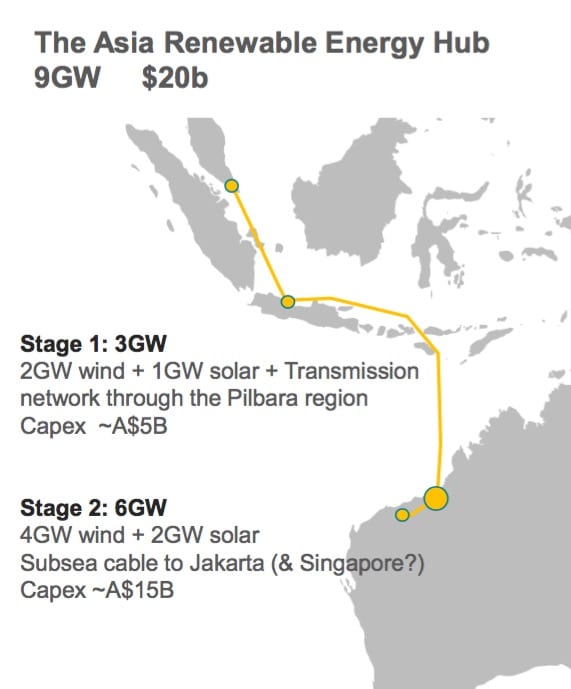The consortium behind an ambitious plan to create an Asian Renewable Energy Hub in the Pilbara region of Western Australia have unveiled plans to add another 3GW of wind and solar to the project to help meet domestic as well as international needs.
The mooted addition will take the potential cost of the project –which envisages exporting cheap wind and solar to Asian customers via subsea cables – to around $20 billion.
The addition of the 3GW of wind and solar will take total generation capacity to around 9GW – with the added capacity targeted at large energy users in the Pilbara, who currently depend on expensive gas and diesel supplies.
The scale of the project is phenomenal. That amount of capacity will generate around 33TWh of wind and solar a year – exactly the amount of wind and solar that is targeted for the whole country by 2020 under the federal renewable energy target.
It would also be the biggest wind-solar hybrid project in the world, could include battery storage, and would likely provide jobs for 3,000 people in the construction phase and 400 people over the long-term operations.
The AREH consortium – which includes global wind turbine manufacturer Vestas, Australia’s CWP Renewables, and Intercontinental Energy – says the extra capacity will allow mine expansions, and the addition of upscale value-added processing.
The 9GW of generation capacity will likely comprise around 6GW of wind generation and 3GW of solar PV generation, and could also include hydrogen storage facilities for domestic use and export.
The Pilbara is generally known for its excellent solar resources, but CWP says it has also found a major wind resource in the area, and the shift to even larger turbines has dramatically increased its assumed potential.
There is a relatively consistent wind speed of 8.2 metres per second. Transmission losses to Asia are estimated to be about 9 per cent over 3,000km.
Andrew Dickson, from CWP says the consortium found the site –between Broome and Port Hedland – after a 12 month search. “We had a hunch there was good wind. The more we look at it, the more the economics improve,” he told RenewEconomy.
Dickson said the project could almost be seen in two components: the export side depending on contracts overseas; but the domestic component could potentially be a stand-alone project, or a precursor, given the cost advantage of renewables over gas.
That idea has been embraced by the Pilbara Development Commission, whose chairman Brendan Hammond said the addition of a domestic energy component meant that local business could capitalise on the Pilbara’s natural wind and solar assets.
“It is an exciting opportunity to boost the business competitiveness of the Pilbara by significantly lowering the cost of energy,” Hammond said in a statement.
“Such an outcome will result in the extension of existing mineral and oil/gas reserves, bring new opportunities into play, and allow a diversified downstream economy that is ultimately independent of natural resource exploitation to be built both regionally and state-wide.”
This is the same thinking that saw Korean-owned Sun Metals build a 124MW solar farm to lower costs for its zinc refinery in north Queensland, and underpin a $300 million expansion.
And it is also why UK “green steel” billionaire Sanjeev Gupta has turned to solar and storage to underpin the future of the Australian steel business, including a solar deal to help power his Victoria steel mill.
 AREH Project Director Alex Tancock said increases in wind turbine size and capacity had led to the decision to add the extra capacity.
AREH Project Director Alex Tancock said increases in wind turbine size and capacity had led to the decision to add the extra capacity.
“The large scale of our project, together with excellent and complementary wind and solar resources, will allow us to generate clean electricity very cost competitively, day and night.
The consortium says the project, ambitious as it is, is gathering momentum with the completion of onshore site ecology surveys, the completion of the nearshore seabed surveys for the subsea cable, and the lodgement of referrals to the WA and Commonwealth governments.
It has also opened a consortium office in Jakarta, and expects to submit its Environmental Impact Assessment to the WA state government in mid-2018.
It says financial close for the project is anticipated in 2020/21, and the construction is anticipated to commence in 2023.












